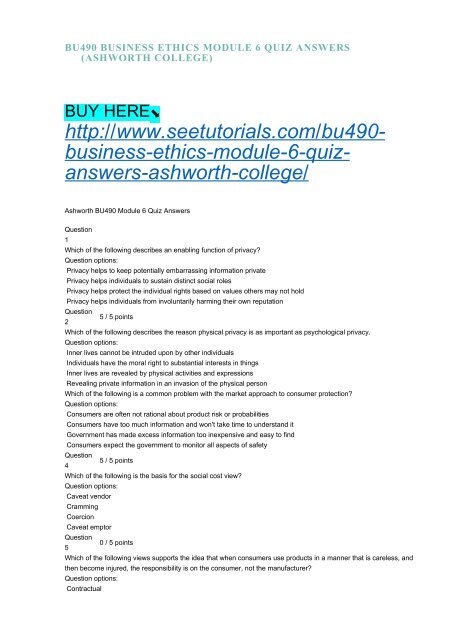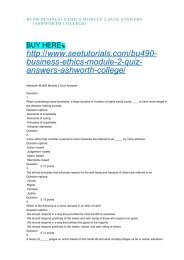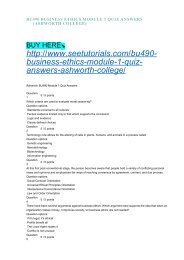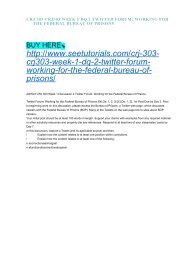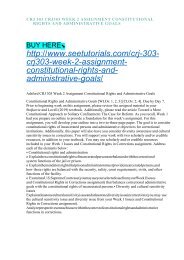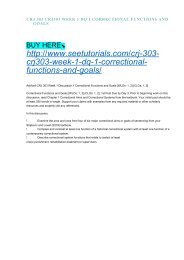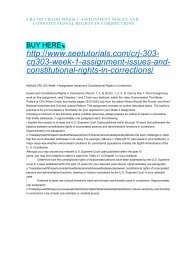BU490 BUSINESS ETHICS MODULE 6 QUIZ ANSWERS (ASHWORTH COLLEGE)
You also want an ePaper? Increase the reach of your titles
YUMPU automatically turns print PDFs into web optimized ePapers that Google loves.
<strong>BU490</strong> <strong>BUSINESS</strong> <strong>ETHICS</strong> <strong>MODULE</strong> 6 <strong>QUIZ</strong> <strong>ANSWERS</strong><br />
(<strong>ASHWORTH</strong> <strong>COLLEGE</strong>)<br />
BUY HERE⬊<br />
http://www.seetutorials.com/bu490-<br />
business-ethics-module-6-quizanswers-ashworth-college/<br />
Ashworth <strong>BU490</strong> Module 6 Quiz Answers<br />
Question<br />
1<br />
Which of the following describes an enabling function of privacy?<br />
Question options:<br />
Privacy helps to keep potentially embarrassing information private<br />
Privacy helps individuals to sustain distinct social roles<br />
Privacy helps protect the individual rights based on values others may not hold<br />
Privacy helps individuals from involuntarily harming their own reputation<br />
Question<br />
5 / 5 points<br />
2<br />
Which of the following describes the reason physical privacy is as important as psychological privacy.<br />
Question options:<br />
Inner lives cannot be intruded upon by other individuals<br />
Individuals have the moral right to substantial interests in things<br />
Inner lives are revealed by physical activities and expressions<br />
Revealing private information in an invasion of the physical person<br />
Which of the following is a common problem with the market approach to consumer protection?<br />
Question options:<br />
Consumers are often not rational about product risk or probabilities<br />
Consumers have too much information and won't take time to understand it<br />
Government has made excess information too inexpensive and easy to find<br />
Consumers expect the government to monitor all aspects of safety<br />
Question<br />
5 / 5 points<br />
4<br />
Which of the following is the basis for the social cost view?<br />
Question options:<br />
Caveat vendor<br />
Cramming<br />
Coercion<br />
Caveat emptor<br />
Question<br />
0 / 5 points<br />
5<br />
Which of the following views supports the idea that when consumers use products in a manner that is careless, and<br />
then become injured, the responsibility is on the consumer, not the manufacturer?<br />
Question options:<br />
Contractual
Due- care<br />
Social cost<br />
Irrational purchases<br />
Question<br />
0 / 5 points<br />
6<br />
Which of the following is one of the main objections to the contractual view of a business firm's duties to its<br />
customers?<br />
Question options:<br />
The use of indirect agreements that cover implied warranties<br />
The idea that buyers and sellers are equal in the transaction<br />
The assumption that sellers deal directly with buyers<br />
The enforcement of the doctrine of caveat emptor<br />
Question<br />
5 / 5 points<br />
7<br />
Under the due-care view of moral responsibility, why do manufacturers have a greater duty to take care to ensure<br />
that consumers' interests are not harmed by the products they offer?<br />
Question options:<br />
Manufacturers have greater knowledge and expertise that consumers lack<br />
There is a strong bond of trust between consumers and manufacturers<br />
Consumers have less time to adequately research goods and services before purchase decisions<br />
Manufacturers have more time to consider the needs of each consumer and how they will use a product or service<br />
Question<br />
5 / 5 points<br />
8<br />
In the due care theory of manufacturer's duties, the relationship between manufacturer and customer can be<br />
described as which of the following?<br />
Question options:<br />
The manufacturer is in an unequal position to harm and take advantage of the customer<br />
They are equals<br />
The customer is in an unequal position to place demands on the manufacturer<br />
The manufacturer and the customer are separated by a regulating body<br />
Question<br />
5 / 5 points<br />
9<br />
Which of the following represents an argument for the market approach to consumer protection?<br />
Question options:<br />
More demands for safety means government should not have to interfere<br />
Sellers will provide safety even if consumers do not demand it<br />
More demand for safety encourages more safety<br />
Government intervention makes the market fair, efficient, and less coercive<br />
Question<br />
5 / 5 points<br />
10<br />
Which of the following is based on the idea that consumers and sellers are not equals in the transactional<br />
relationship?<br />
Question options:<br />
The doctrine of caveat emptor<br />
The Uniform Commercial Code<br />
The social costs view<br />
The due- care view<br />
Question<br />
5 / 5 points<br />
11<br />
Which of the following represents the responsibility of a manufacture under the due-care view of business<br />
responsibility?<br />
Question options:<br />
Consumers and sellers are equally skilled in evaluating the quality of a product, and they must protect their own best
interests<br />
Consumers depend on the expertise of the manufacturer; therefore, the manufacturer must take due care to ensure<br />
others are not injured by the product<br />
Consumers are free to agree to buy a product with certain qualities, and they are also free to buy products with other<br />
qualities<br />
The seller has a moral responsibility to the buyer of its product, often a wholesaler, and does not have a due- care<br />
relationship with the end- user of the product, often a consumer<br />
Question<br />
5 / 5 points<br />
12<br />
According to the contractual view of the business firm's duties to its customers, what is created by the contractual<br />
relationship between a firm and its customers?<br />
Question options:<br />
Universalized contracts<br />
Moral duties<br />
Social rules<br />
Secondary duties<br />
Question<br />
5 / 5 points<br />
13<br />
Which of the following represents a major fault in the due-care view of moral responsibility?<br />
Question options:<br />
It places the cost for unforeseen product injuries in the hands of the manufacturer<br />
It requires the consumers to use products in a way that minimizes risk of injury or harm<br />
It requires the manufacturer to determine how much risk is acceptable for the consumer<br />
It identifies specific formulas to determine the levels of due care required for each product<br />
Question<br />
5 / 5 points<br />
14<br />
Which of the following views of the manufacturers' duties to consumers holds that the manufacturer should pay the<br />
cost of injuries sustained through defects in the product, even when due care has been exercised?<br />
Question options:<br />
The due- care view of business responsibility<br />
The contractual view of manufacturers' responsibilities<br />
The duty of disclosure<br />
The social costs view of the manufacturers' duties<br />
Question<br />
0 / 5 points<br />
15<br />
Which of the following describes a person's thoughts, beliefs, values, and feelings?<br />
Question options:<br />
Moral rights<br />
Physical privacy<br />
Ethical rights<br />
Physiological privacy<br />
Question<br />
5 / 5 points<br />
16<br />
Which of the following criticisms of the social cost view supports the idea that the social cost view is unjust?<br />
Question options:<br />
The social cost view assumes that being required to pay for the cost of injuries will inspire manufacturers to reduce<br />
the number of accidents<br />
The social cost view required manufacturers to pay for unforeseeable and unpreventable injuries<br />
The social cost view has increased the number of lawsuits under the strict liability claim<br />
The social cost view does not consider the standard utilitarian assumptions about the values of efficiency<br />
Question<br />
5 / 5 points<br />
17
Which of the following represents the idea that a business has a moral responsibility to fully explain what a buyer is<br />
purchasing and exactly what the terms of the sale are?<br />
Question options:<br />
The duty not to misrepresent<br />
The duty not to coerce<br />
The duty to comply with express claims<br />
The duty of disclosure<br />
Question<br />
5 / 5 points<br />
18<br />
In terms of product safety, what is the potential result of government intervention in consumer markets?<br />
Question options:<br />
Safety is reduced to a commodity that must be provided even if unwanted<br />
Markets become unfair, inefficient, and coercive<br />
The government bears the added cost of incorporating safety<br />
Consumers will pay extra for safety if sellers provide it<br />
Question<br />
5 / 5 points<br />
19<br />
Which implied claim refers to the estimated amount of time a product will function as effectively as a consumer is led<br />
to believe it will?<br />
Question options:<br />
Reliability<br />
Service life<br />
Maintainability<br />
Product safety<br />
Question<br />
5 / 5 points<br />
20<br />
Some advertisements that are intended to manipulate consumers violate what right?<br />
Question options:<br />
The right to free speech<br />
The consumer's right to be treated as a free and equal rational being<br />
The right to choose between competitors in a free market<br />
The right to personal safety


